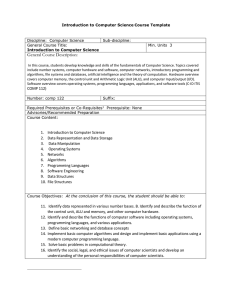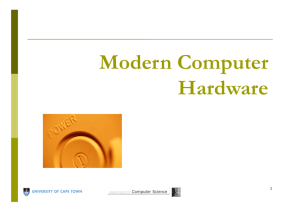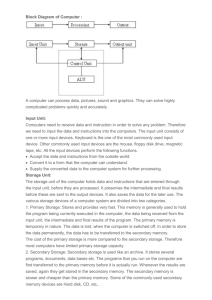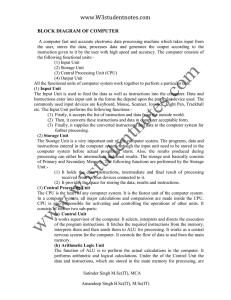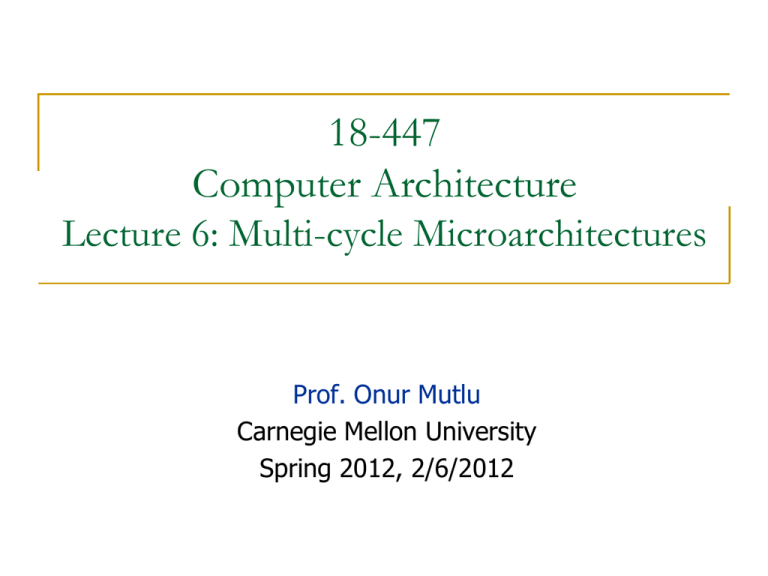
18-447
Computer Architecture
Lecture 6: Multi-cycle Microarchitectures
Prof. Onur Mutlu
Carnegie Mellon University
Spring 2012, 2/6/2012
Reminder: Homeworks
Homework 1 solutions
Check and study the solutions!
Learning now is better than rushing later
Homework 2
Already out
Due February 13
ISA concepts, ISA vs. microarchitecture, microcoded machines
2
Reminder: Lab Assignment 2
Lab Assignment 1.5
Verilog practice
Not to be turned in
Lab Assignment 2
Due Friday, Feb 17, at the end of the lab
Individual assignment
No collaboration; please respect the honor code
3
Extra Credit for Lab Assignment 2
Complete your normal (single-cycle) implementation first,
and get it checked off in lab.
Then, implement the MIPS core using a microcoded
approach similar to what we are discussing in class.
We are not specifying any particular details of the
microcode format or the microarchitecture; you should be
creative.
For the extra credit, the microcoded implementation should
execute the same programs that your ordinary
implementation does, and you should demo it by the
normal lab deadline.
4
Feedback on Lab Assignment 1
Chris, Lavanya, and Abeer are working hard on grading
Be thorough and test all possible cases
Follow directions – they are there for a reason
We will have very comprehensive tests for all labs
Lab 1 tests exercise every case of each instruction as well as
long programs (e.g., REP MOVS)
We will release test cases and register dumps
No modifications to shell code!
No unaligned accesses to memory
Remove all your debugging printf’s before handing in code
Do the extra credit work if the lab is too easy!
5
Readings for Today
P&P, Revised Appendix C
P&H, Appendix D
Microarchitecture of the LC-3b
Appendix A (LC-3b ISA) will be useful in following this
Mapping Control to Hardware
Optional
Maurice Wilkes, “The Best Way to Design an Automatic
Calculating Machine,” Manchester Univ. Computer Inaugural
Conf., 1951.
6
Readings for Next Lecture
Pipelining
P&H Chapter 4.5-4.8
7
Review of Last Lecture: Single-Cycle Uarch
What phases of the instruction processing cycle does the
MIPS JAL instruction exercise?
How many cycles does it take to process an instruction in
the single-cycle microarchitecture?
What is the difference between datapath and control logic?
What determines the clock cycle time?
What about combinational vs. sequential control?
What is the semantics of a delayed branch?
Why this is so will become clear when we cover pipelining
8
Review: Instruction Processing “Cycle”
Instructions are processed under the direction of a “control
unit” step by step.
Instruction cycle: Sequence of steps to process an instruction
Fundamentally, there are six phases:
Fetch
Decode
Evaluate Address
Fetch Operands
Execute
Store Result
Not all instructions require all six stages (see P&P Ch. 4)
9
Review: Datapath vs. Control Logic
Instructions transform Data (AS) to Data’ (AS’)
This transformation is done by functional units
Units that “operate” on data
These units need to be told what to do to the data
An instruction processing engine consists of two components
Datapath: Consists of hardware elements that deal with and
transform data signals
functional units that operate on data
hardware structures (e.g. wires and muxes) that enable the flow of
data into the functional units and registers
storage units that store data (e.g., registers)
Control logic: Consists of hardware elements that determine
control signals, i.e., signals that specify what the datapath
elements should do to the data
10
Today’s Agenda
Finish single-cycle microarchitectures
Critical path
Microarchitecture design principles
Performance evaluation primer
Multi-cycle microarchitectures
Microprogrammed control
11
A Note: How to Make the Best Out of 447?
Do the readings
Do the assignments early
P&P Appendixes A and C
Wilkes 1951 paper
Today’s lectures will be easy to understand if you read these
And, you can ask more in-depth questions and learn more
You can do things for extra credit if you finish early
We will describe what to do for extra credit
Study the material and buzzwords daily
Lecture notes, videos
Buzzwords take notes during class
12
Review: The Full Single-Cycle Datapath
Instruction [25– 0]
26
Shift
left 2
PCSrc1=Jump
Jump address [31– 0]
28
PC+4 [31– 28]
ALU
Add result
Add
4
Instruction [31– 26]
Control
Instruction [25– 21]
PC
Read
address
Instruction
memory
Instruction [15– 11]
M
u
x
1
0
PCSrc2=Br Taken
Shift
left 2
RegDst
Jump
Branch
MemRead
MemtoReg
ALUOp
MemWrite
ALUSrc
RegWrite
0
M
u
x
1
Read
data 1
Read
register 2
Registers Read
Write
data 2
register
0
M
u
x
1
Write
data
Zero
bcond
ALU ALU
result
Address
Write
data
Instruction [15– 0]
1
M
u
x
Read
register 1
Instruction [20– 16]
Instruction
[31– 0]
0
16
Sign
extend
Read
data
Data
memory
1
M
u
x
0
32
ALU
control
ALU operation
Instruction [5– 0]
**Based on original figure from [P&H CO&D, COPYRIGHT 2004 Elsevier.
ALL RIGHTS RESERVED.]
13
JAL, JR, JALR omitted
Single-Cycle Datapath for
Arithmetic and Logical Instructions
14
Review: Datapath for R and I-Type ALU Insts.
Add
4
PC
25:21
Read
address
20:16
Instruction
Instruction
Instruction
memory
15:11
RegDest
isItype
3
Read
register 1
Read
register 2
Registers
Write
register
Write
data
Zero
ALU ALU
result
GPR[rt] GPR[rs] + sign-extend (immediate)
PC PC + 4
**Based on original figure from [P&H CO&D, COPYRIGHT 2004 Elsevier. ALL RIGHTS RESERVED.]
Address
Read
data 2
Write
data
ALUSrc
Sign
extend
IF
if MEM[PC] == ADDI rt rs immediate
Mem
Read
data 1
RegWrite
116
ALU operation
32
Data
memo
isItype
ID
Mem
EX
MEM WB
Combinational
state update logic 15
Single-Cycle Datapath for
Data Movement Instructions
16
Review: Datapath for Non-Control-Flow Insts.
Add
4
PC
Read
register 1
Read
address
Instruction
Instruction
Instruction
memory
Read
register 2
Registers
Write
register
Write
data
RegDest
isItype
3
MemWrite
Read
data 1
Zero
ALU ALU
result
Read
data
Address
Read
data 2
RegWrite
!isStore
16
isStore
ALU operation
Sign
extend
32
ALUSrc
isItype
Write
data
Data
memory
MemRead
isLoad
MemtoReg
isLoad
**Based on original figure from [P&H CO&D, COPYRIGHT 2004 Elsevier. ALL RIGHTS RESERVED.]
17
Single-Cycle Datapath for
Control Flow Instructions
18
Review: Unconditional Jump Instructions
Assembly
J immediate26
Machine encoding
J
immediate
6-bit
26-bit
J-type
Semantics
if MEM[PC]==J immediate26
target = { PC[31:28], immediate26, 2’b00 }
PC target
19
Review: Unconditional Jump Datapath
isJ
Add
PCSrc
4
PC
Read
register 1
Read
address
Instruction
concat
Read
register 2
Registers
Write
register
Instruction
Instruction
memory
?
Write
data
3
XALU operation
MemWrite
Read
data 1
Zero
ALU ALU
result
**Based on original figure from [P&H CO&D, COPYRIGHT
2004 Elsevier. ALL RIGHTS RESERVED.]
if MEM[PC]==J immediate26
PC = { PC[31:28], immediate26, 2’b00 }
Read
data
Address
Read
data 2
RegWrite
0 16
0
Sign
extend
32
ALUSrc
X
Write
data
Data
memory
MemRead
0
20
What about JR, JAL, JALR?
Conditional Branch Instructions
Assembly (e.g., branch if equal)
BEQ rsreg rtreg immediate16
Machine encoding
BEQ
rs
rt
immediate
6-bit
5-bit
5-bit
16-bit
I-type
Semantics (assuming no branch delay slot)
if MEM[PC]==BEQ rs rt immediate16
target = PC + 4 + sign-extend(immediate) x 4
if GPR[rs]==GPR[rt] then PC target
else
PC PC + 4
21
Conditional Branch Datapath (For You to Fix)
watch out
PC + 4 from instruction datapath
Add
PCSrc
Add Sum
4
PC
Shift
left 2
Read
address
Instruction
concat
Instruction
memory
Instruction
Branch target
sub
ALU operation
3
Read
register 1
Read
register 2
Registers
Write
register
Write
data
Read
data 1
ALU bcond
Zero
To branch
control logic
Read
data 2
RegWrite
0
16
Sign
extend
32
**Based on original figure from [P&H CO&D, COPYRIGHT 2004 Elsevier. ALL RIGHTS RESERVED.]
22
How to uphold the delayed branch semantics?
Putting It All Together
Instruction [25– 0]
26
Shift
left 2
PCSrc1=Jump
Jump address [31– 0]
28
PC+4 [31– 28]
ALU
Add result
Add
4
Instruction [31– 26]
Control
Instruction [25– 21]
PC
Read
address
Instruction
memory
Instruction [15– 11]
M
u
x
1
0
PCSrc2=Br Taken
Shift
left 2
RegDst
Jump
Branch
MemRead
MemtoReg
ALUOp
MemWrite
ALUSrc
RegWrite
0
M
u
x
1
Read
data 1
Read
register 2
Registers Read
Write
data 2
register
0
M
u
x
1
Write
data
Zero
bcond
ALU ALU
result
Address
Write
data
Instruction [15– 0]
1
M
u
x
Read
register 1
Instruction [20– 16]
Instruction
[31– 0]
0
16
Sign
extend
Read
data
Data
memory
1
M
u
x
0
32
ALU
control
ALU operation
Instruction [5– 0]
**Based on original figure from [P&H CO&D, COPYRIGHT 2004 Elsevier.
ALL RIGHTS RESERVED.]
23
JAL, JR, JALR omitted
Single-Cycle Control Logic
24
Single-Cycle Hardwired Control
As combinational function of Inst=MEM[PC]
31
21
16
11
6
0
0
rs
rt
rd
shamt
funct
6-bit
5-bit
5-bit
5-bit
5-bit
6-bit
31
26
21
16
0
opcode
rs
rt
immediate
6-bit
5-bit
5-bit
16-bit
31
26
26
0
opcode
immediate
6-bit
26-bit
R-type
I-type
J-type
Consider
All R-type and I-type ALU instructions
LW and SW
BEQ, BNE, BLEZ, BGTZ
J, JR, JAL, JALR
25
Single-Bit Control Signals
When De-asserted
RegDest
When asserted
Equation
GPR write select
according to rt, i.e.,
inst[20:16]
GPR write select
according to rd, i.e.,
inst[15:11]
opcode==0
2nd ALU input from 2nd
GPR read port
2nd ALU input from signextended 16-bit
immediate
(opcode!=0) &&
(opcode!=BEQ) &&
(opcode!=BNE)
Steer ALU result to GPR
write port
steer memory load to
GPR wr. port
opcode==LW
ALUSrc
26
JAL and JALR require additional RegDest and MemtoReg options
Single-Bit Control Signals
When De-asserted
When asserted
Equation
Memory read disabled
Memory read port
return load value
opcode==LW
Memory write disabled
Memory write enabled
opcode==SW
According to PCSrc2
next PC is based on 26bit immediate jump
target
(opcode==J) ||
next PC is based on 16bit immediate branch
target
(opcode==Bxx) &&
MemRead
MemWrite
PCSrc1
next PC = PC + 4
PCSrc2
(opcode==JAL)
“bcond is satisfied”
27
JR and JALR require additional PCSrc options
ALU Control
case opcode
‘0’ select operation according to funct
‘ALUi’ selection operation according to opcode
‘LW’ select addition
‘SW’ select addition
‘Bxx’ select bcond generation function
__ don’t care
Example ALU operations
ADD, SUB, AND, OR, XOR, NOR, etc.
bcond on equal, not equal, LE zero, GT zero, etc.
28
R-Type ALU
Instruction [25– 0]
26
Shift
left 2
PCSrc1=Jump
Jump address [31– 0]
28
PC+4 [31– 28]
ALU
Add result
Add
4
Instruction [31– 26]
Control
Instruction [25– 21]
PC
Read
address
Read
register 1
Instruction [20– 16]
Instruction
[31– 0]
Instruction
memory
Instruction [15– 11]
RegDst
Jump
Branch
MemRead
MemtoReg
ALUOp
MemWrite
ALUSrc
RegWrite
0
M
u
x
1
1
M
u
x
M
u
x
1
0
PCSrc2=Br Taken
Shift
left 2
1
0
Read
data 1
Read
register 2
Registers Read
Write
data 2
register
0
M
u
x
1
Write
data
Zero
bcond
ALU ALU
result
16
Sign
extend
Read
data
Address
Write
data
Instruction [15– 0]
0
Data
memory
1
M
u
x
0
32
funct ALU operation
ALU
control
0
Instruction [5– 0]
**Based on original figure from [P&H CO&D, COPYRIGHT
2004 Elsevier. ALL RIGHTS RESERVED.]
29
I-Type ALU
Instruction [25– 0]
26
Shift
left 2
PCSrc1=Jump
Jump address [31– 0]
28
PC+4 [31– 28]
ALU
Add result
Add
4
Instruction [31– 26]
Control
Instruction [25– 21]
PC
Read
address
Instruction
memory
Read
register 1
Instruction [20– 16]
Instruction
[31– 0]
Instruction [15– 11]
RegDst
Jump
Branch
MemRead
MemtoReg
ALUOp
MemWrite
ALUSrc
RegWrite
0
M
u
x
1
1
M
u
x
M
u
x
1
0
PCSrc2=Br Taken
Shift
left 2
1
0
Read
data 1
Read
register 2
Registers Read
Write
data 2
register
0
M
u
x
1
Write
data
Zero
bcond
ALU ALU
result
16
Sign
extend
Read
data
Address
Write
data
Instruction [15– 0]
0
Data
memory
1
M
u
x
0
32
opcodeALU operation
ALU
control
0
Instruction [5– 0]
**Based on original figure from [P&H CO&D, COPYRIGHT 2004
Elsevier. ALL RIGHTS RESERVED.]
30
LW
Instruction [25– 0]
26
Shift
left 2
PCSrc1=Jump
Jump address [31– 0]
28
PC+4 [31– 28]
ALU
Add result
Add
4
Instruction [31– 26]
Control
Instruction [25– 21]
PC
Read
address
Instruction
memory
Read
register 1
Instruction [20– 16]
Instruction
[31– 0]
Instruction [15– 11]
RegDst
Jump
Branch
MemRead
MemtoReg
ALUOp
MemWrite
ALUSrc
RegWrite
0
M
u
x
1
1
M
u
x
M
u
x
1
0
PCSrc2=Br Taken
Shift
left 2
1
0
Read
data 1
Read
register 2
Registers Read
Write
data 2
register
0
M
u
x
1
Write
data
Zero
bcond
ALU ALU
result
16
Sign
extend
Read
data
Address
Write
data
Instruction [15– 0]
0
Data
memory
1
M
u
x
0
32
Add
ALU
control
ALU operation
1
Instruction [5– 0]
**Based on original figure from [P&H CO&D, COPYRIGHT 2004
Elsevier. ALL RIGHTS RESERVED.]
31
SW
Instruction [25– 0]
26
Shift
left 2
PCSrc1=Jump
Jump address [31– 0]
28
PC+4 [31– 28]
ALU
Add result
Add
4
Instruction [31– 26]
Control
Instruction [25– 21]
PC
Read
address
Instruction
memory
Read
register 1
Instruction [20– 16]
Instruction
[31– 0]
Instruction [15– 11]
RegDst
Jump
Branch
MemRead
MemtoReg
ALUOp
MemWrite
ALUSrc
RegWrite
0
M
u
x
1
*
1
M
u
x
M
u
x
1
0
PCSrc2=Br Taken
Shift
left 2
0
1
Read
data 1
Read
register 2
Registers Read
Write
data 2
register
0
M
u
x
1
Write
data
Zero
bcond
ALU ALU
result
16
Sign
extend
Read
data
Address
Write
data
Instruction [15– 0]
0
Data
memory
1
M
u
x
0
*
32
Add
ALU
control
ALU operation
0
Instruction [5– 0]
**Based on original figure from [P&H CO&D, COPYRIGHT 2004
Elsevier. ALL RIGHTS RESERVED.]
32
Branch Not Taken
Instruction [25– 0]
26
Shift
left 2
PCSrc1=Jump
Jump address [31– 0]
28
PC+4 [31– 28]
ALU
Add result
Add
4
Instruction [31– 26]
Control
Instruction [25– 21]
PC
Read
address
Instruction
memory
Read
register 1
Instruction [20– 16]
Instruction
[31– 0]
Instruction [15– 11]
Instruction [15– 0]
RegDst
Jump
Branch
MemRead
MemtoReg
ALUOp
MemWrite
ALUSrc
RegWrite
0
M
u
x
1
*
0
1
M
u
x
M
u
x
1
0
PCSrc2=Br Taken
Shift
left 2
0
0
Read
data 1
Read
register 2
Registers Read
Write
data 2
register
0
M
u
x
1
Write
data
Zero
bcond
ALU ALU
result
Write
data
16
Sign
extend
Read
data
Address
Data
memory
1
M
u
x
0
*
32
bcondALU operation
ALU
control
0
Instruction [5– 0]
**Based on original figure from [P&H CO&D, COPYRIGHT 2004
Elsevier. ALL RIGHTS RESERVED.]
33
Branch Taken
Instruction [25– 0]
26
Shift
left 2
PCSrc1=Jump
Jump address [31– 0]
28
PC+4 [31– 28]
ALU
Add result
Add
4
Instruction [31– 26]
Control
Instruction [25– 21]
PC
Read
address
Read
register 1
Instruction [20– 16]
Instruction
[31– 0]
Instruction
memory
Instruction [15– 11]
Instruction [15– 0]
RegDst
Jump
Branch
MemRead
MemtoReg
ALUOp
MemWrite
ALUSrc
RegWrite
0
M
u
x
1
*
0
1
M
u
x
M
u
x
1
0
PCSrc2=Br Taken
Shift
left 2
0
0
Read
data 1
Read
register 2
Registers Read
Write
data 2
register
0
M
u
x
1
Write
data
Zero
bcond
ALU ALU
result
Write
data
16
Sign
extend
Read
data
Address
Data
memory
1
M
u
x
0
*
32
bcondALU operation
ALU
control
0
Instruction [5– 0]
**Based on original figure from [P&H CO&D, COPYRIGHT
2004 Elsevier. ALL RIGHTS RESERVED.]
34
Jump
Instruction [25– 0]
26
Shift
left 2
PCSrc1=Jump
Jump address [31– 0]
28
PC+4 [31– 28]
4
Instruction [31– 26]
Control
Instruction [25– 21]
PC
Read
address
Read
register 1
Instruction [20– 16]
Instruction
[31– 0]
Instruction
memory
Instruction [15– 11]
Instruction [15– 0]
RegDst
Jump
Branch
MemRead
MemtoReg
ALUOp
MemWrite
ALUSrc
RegWrite
0
M
u
x
1
*
M
u
x
M
u
x
1
0
PCSrc2=Br Taken
Shift
left 2
0
0
Read
data 1
Read
register 2
Registers Read
Write
data 2
register
0
M
u
x
1
*
Write
data
16
Instruction [5– 0]
**Based on original figure from [P&H CO&D, COPYRIGHT
2004 Elsevier. ALL RIGHTS RESERVED.]
1
*
ALU
Add result
Add
0
Sign
extend
Zero
bcond
ALU ALU
result
Read
data
Address
Write
data
Data
memory
1
M
u
x
0
*
32
*
ALU
control
ALU operation
0
35
What is in That Control Box?
Combinational Logic Hardwired Control
Idea: Control signals generated combinationally based on
instruction
Sequential Logic Sequential/Microprogrammed Control
Control Store
Idea: A memory structure contains the control signals
associated with an instruction
36
Evaluating the Single-Cycle
Microarchitecture
37
A Single-Cycle Microarchitecture
Is this a good idea/design?
When is this a good design?
When is this a bad design?
How can we design a better microarchitecture?
38
A Single-Cycle Microarchitecture: Analysis
Every instruction takes 1 cycle to execute
How long each instruction takes is determined by how long
the slowest instruction takes to execute
CPI (Cycles per instruction) is strictly 1
Even though many instructions do not need that long to
execute
Clock cycle time of the microarchitecture is determined by
how long it takes to complete the slowest instruction
Critical path of the design is determined by the processing
time of the slowest instruction
39
What is the Slowest Instruction to Process?
Let’s go back to the basics
All six phases of the instruction processing cycle take a single
machine clock cycle to complete
Fetch
1. Instruction fetch (IF)
Decode
2. Instruction decode and
register operand fetch (ID/RF)
Evaluate Address
3. Execute/Evaluate memory address (EX/AG)
Fetch Operands
4. Memory operand fetch (MEM)
Execute
5. Store/writeback result (WB)
Store Result
Do each of the above phases take the same time (latency)
for all instructions?
40
Single-Cycle Datapath Analysis
Assume
memory units (read or write): 200 ps
ALU and adders: 100 ps
register file (read or write): 50 ps
other combinational logic: 0 ps
steps
IF
ID
EX
MEM
mem
WB
RF
Delay
resources
mem
RF
ALU
R-type
200
50
100
50
400
I-type
200
50
100
50
400
LW
200
50
100
200
50
600
SW
200
50
100
200
Branch
200
50
100
Jump
200
550
350
200
41
Let’s Find the Critical Path
Instruction [25– 0]
26
Shift
left 2
PCSrc1=Jump
Jump address [31– 0]
28
PC+4 [31– 28]
ALU
Add result
Add
4
Instruction [31– 26]
Control
Instruction [25– 21]
PC
Read
address
Instruction
memory
Instruction [15– 11]
M
u
x
M
u
x
1
0
PCSrc2=Br Taken
Shift
left 2
RegDst
Jump
Branch
MemRead
MemtoReg
ALUOp
MemWrite
ALUSrc
RegWrite
0
M
u
x
1
Read
data 1
Read
register 2
Registers Read
Write
data 2
register
0
M
u
x
1
Write
data
Zero
bcond
ALU ALU
result
Address
Write
data
Instruction [15– 0]
1
Read
register 1
Instruction [20– 16]
Instruction
[31– 0]
0
16
Sign
extend
Read
data
Data
memory
1
M
u
x
0
32
ALU
control
ALU operation
Instruction [5– 0]
[Based on original figure from P&H CO&D, COPYRIGHT 2004
Elsevier. ALL RIGHTS RESERVED.]
42
R-Type and I-Type ALU
Instruction [25– 0]
26
Shift
left 2
PCSrc1=Jump
Jump address [31– 0]
28
PC+4 [31– 28]
Add
ALU
Add result
100ps
4
Instruction [31– 26]
Control
100ps
Instruction [25– 21]
PC
Read
address
200ps
Instruction
memory
Instruction [15– 11]
M
u
x
M
u
x
1
0
PCSrc2=Br Taken
Shift
left 2
RegDst
Jump
Branch
MemRead
MemtoReg
ALUOp
MemWrite
ALUSrc
RegWrite
0
M
u
x
1
Read
data 1
Read
register 2
Registers Read
Write
data 2
register
Write
data
250ps
400ps
0
M
u
x
1
Zero
bcond
ALU ALU
result
Address
350ps
Write
data
Instruction [15– 0]
1
Read
register 1
Instruction [20– 16]
Instruction
[31– 0]
0
16
Sign
extend
Read
data
Data
memory
1
M
u
x
0
32
ALU
control
ALU operation
Instruction [5– 0]
[Based on original figure from P&H CO&D, COPYRIGHT
2004 Elsevier. ALL RIGHTS RESERVED.]
43
LW
Instruction [25– 0]
26
Shift
left 2
PCSrc1=Jump
Jump address [31– 0]
28
PC+4 [31– 28]
Add
ALU
Add result
100ps
4
Instruction [31– 26]
Control
100ps
Instruction [25– 21]
PC
Read
address
200ps
Instruction
memory
Instruction [15– 11]
Instruction [15– 0]
1
M
u
x
M
u
x
1
0
PCSrc2=Br Taken
Shift
left 2
RegDst
Jump
Branch
MemRead
MemtoReg
ALUOp
MemWrite
ALUSrc
RegWrite
Read
register 1
Instruction [20– 16]
Instruction
[31– 0]
0
0
M
u
x
1
Read
data 1
Read
register 2
Registers Read
Write
data 2
register
250ps
0
M
u
x
1
Write
data
600ps
16
Zero
bcond
ALU ALU
result
Address
350ps
Write
data
Sign
extend
Read
data
Data
memory
550ps
1
M
u
x
0
32
ALU
control
ALU operation
Instruction [5– 0]
[Based on original figure from P&H CO&D, COPYRIGHT
2004 Elsevier. ALL RIGHTS RESERVED.]
44
SW
Instruction [25– 0]
26
Shift
left 2
PCSrc1=Jump
Jump address [31– 0]
28
PC+4 [31– 28]
Add
ALU
Add result
100ps
4
Instruction [31– 26]
Control
100ps
Instruction [25– 21]
PC
Read
address
200ps
Instruction
memory
Instruction [15– 11]
M
u
x
M
u
x
1
0
PCSrc2=Br Taken
Shift
left 2
RegDst
Jump
Branch
MemRead
MemtoReg
ALUOp
MemWrite
ALUSrc
RegWrite
0
M
u
x
1
Read
data 1
Read
register 2
Registers Read
Write
data 2
register
250ps
0
M
u
x
1
Write
data
Zero
bcond
ALU ALU
result
Address
16
Sign
extend
Read
data
350ps 550ps
Write
data
Instruction [15– 0]
1
Read
register 1
Instruction [20– 16]
Instruction
[31– 0]
0
Data
memory
1
M
u
x
0
32
ALU
control
ALU operation
Instruction [5– 0]
[Based on original figure from P&H CO&D, COPYRIGHT
2004 Elsevier. ALL RIGHTS RESERVED.]
45
Branch Taken
Instruction [25– 0]
26
Shift
left 2
PCSrc1=Jump
Jump address [31– 0]
28
200ps
PC+4 [31– 28]
100ps
ALU
Add result
Add
4
Instruction [31– 26]
Control
350ps
Instruction [25– 21]
PC
Read
address
200ps
Instruction
memory
Instruction [15– 11]
0
M
u
x
1
M
u
x
M
u
x
1
0
PCSrc2=Br Taken
Read
data 1
Read
register 2
Registers Read
Write
data 2
register
350ps
250ps
0
M
u
x
1
Write
data
Zero
bcond
ALU ALU
result
Address
Write
data
Instruction [15– 0]
1
Shift
left 2
RegDst
Jump
Branch
MemRead
MemtoReg
ALUOp
MemWrite
ALUSrc
RegWrite
Read
register 1
Instruction [20– 16]
Instruction
[31– 0]
0
16
Sign
extend
Read
data
Data
memory
1
M
u
x
0
32
ALU
control
ALU operation
Instruction [5– 0]
[Based on original figure from P&H CO&D, COPYRIGHT
2004 Elsevier. ALL RIGHTS RESERVED.]
46
Jump
Instruction [25– 0]
26
Shift
left 2
PCSrc1=Jump
Jump address [31– 0]
28
PC+4 [31– 28]
100ps
ALU
Add result
Add
4
Instruction [31– 26]
Control
200ps
Instruction [25– 21]
PC
Read
address
200ps
Instruction
memory
Instruction [15– 11]
M
u
x
M
u
x
1
0
PCSrc2=Br Taken
Shift
left 2
RegDst
Jump
Branch
MemRead
MemtoReg
ALUOp
MemWrite
ALUSrc
RegWrite
0
M
u
x
1
Read
data 1
Read
register 2
Registers Read
Write
data 2
register
0
M
u
x
1
Write
data
Zero
bcond
ALU ALU
result
Address
Write
data
Instruction [15– 0]
1
Read
register 1
Instruction [20– 16]
Instruction
[31– 0]
0
16
Sign
extend
Read
data
Data
memory
1
M
u
x
0
32
ALU
control
ALU operation
Instruction [5– 0]
[Based on original figure from P&H CO&D, COPYRIGHT
2004 Elsevier. ALL RIGHTS RESERVED.]
47
What About Control Logic?
How does that affect the critical path?
Food for thought for you:
Can control logic be on the critical path?
A note on CDC 5600: control store access too long…
48
What is the Slowest Instruction to Process?
Memory is not magic
What if memory sometimes takes 100ms to access?
Does it make sense to have a simple register to register
add or jump to take {100ms+all else to do a memory
operation}?
And, what if you need to access memory more than once to
process an instruction?
Which instructions need this?
VAX INDEX instruction
Do you provide multiple ports to memory?
49
Single Cycle uArch: Complexity
Contrived
Inefficient
All instructions run as slow as the slowest instruction
Must provide worst-case combinational resources in parallel as required
by any instruction
Need to replicate a resource if it is needed more than once by an
instruction during different parts of the instruction processing cycle
Not necessarily the simplest way to implement an ISA
All instructions run as slow as the slowest instruction
Single-cycle implementation of REP MOVS, INDEX, POLY?
Not easy to optimize/improve performance
Optimizing the common case does not work (e.g. common instructions)
Need to optimize the worst case all the time
50
Microarchitecture Design Principles
Critical path design
Find the maximum combinational logic delay and decrease it
Bread and butter (common case) design
Spend time and resources on where it matters
Common case vs. uncommon case
Balanced design
i.e., improve what the machine is really designed to do
Balance instruction/data flow through hardware components
Balance the hardware needed to accomplish the work
How does a single-cycle microarchitecture fare in light of
these principles?
51
Multi-Cycle Microarchitectures
52
Multi-Cycle Microarchitectures
Goal: Let each instruction take (close to) only as much time
it really needs
Idea
Determine clock cycle time independently of instruction
processing time
Each instruction takes as many clock cycles as it needs to take
Multiple state transitions per instruction
The states followed by each instruction is different
53
Remember: The “Process instruction” Step
ISA specifies abstractly what A’ should be, given an
instruction and A
It defines an abstract finite state machine where
From ISA point of view, there are no “intermediate states”
between A and A’ during instruction execution
State = programmer-visible state
Next-state logic = instruction execution specification
One state transition per instruction
Microarchitecture implements how A is transformed to A’
There are many choices in implementation
We can have programmer-invisible state to optimize the speed of
instruction execution: multiple state transitions per instruction
Choice 1: AS AS’ (transform A to A’ in a single clock cycle)
Choice 2: AS AS+MS1 AS+MS2 AS+MS3 AS’ (take multiple
clock cycles to transform AS to AS’)
54
Multi-Cycle Microarchitecture
AS = Architectural (programmer visible) state
at the beginning of an instruction
Step 1: Process part of instruction in one clock cycle
Step 2: Process part of instruction in the next clock cycle
…
AS’ = Architectural (programmer visible) state
at the end of a clock cycle
55
Benefits of Multi-Cycle Design
Critical path design
Bread and butter (common case) design
Can keep reducing the critical path independently of worst-case
processing time of any instruction
Can optimize the number of states it takes to execute “important”
instructions that make up much of the execution time
Balanced design
No need to provide more capability or resources than really
needed
An instruction that needs resource X multiple times does not require
multiple X’s to be implemented
Leads to more efficient hardware: Can reuse hardware components
needed multiple times for an instruction
56
Performance Analysis
Execution time of an instruction
Execution time of a program
Sum over all instructions [{CPI} x {clock cycle time}]
{# of instructions} x {Average CPI} x {clock cycle time}
Single cycle microarchitecture performance
{CPI} x {clock cycle time}
CPI = 1
Clock cycle time = long
Multi-cycle microarchitecture performance
CPI = different for each instruction
Average CPI hopefully small
Clock cycle time = short
Now, we have
two degrees of freedom
to optimize independently
57
An Aside: CPI vs. Frequency
CPI vs. Clock cycle time
At odds with each other
Reducing one increases the other for a single instruction
Why?
Average CPI can be amortized/reduced via concurrent
processing of multiple instructions
The same cycle is devoted to multiple instructions
Example: Pipelining, superscalar execution
58
A Multi-Cycle Microarchitecture
A Closer Look
59
How Do We Implement This?
Maurice Wilkes, “The Best Way to Design an Automatic
Calculating Machine,” Manchester Univ. Computer
Inaugural Conf., 1951.
The concept of microcoded/microprogrammed machines
Realization
One can implement the “process instruction” step as a finite
state machine that sequences between states and eventually
returns back to the “fetch instruction” state
A state is defined by the control signals asserted in it
Control signals for the next state determined in current state
60
The Instruction Processing Cycle
Fetch
Decode
Evaluate Address
Fetch Operands
Execute
Store Result
61
A Basic Multi-Cycle Microarchitecture
Instruction processing cycle divided into “states”
A multi-cycle microarchitecture sequences from state to
state to process an instruction
A stage in the instruction processing cycle can take multiple states
The behavior of the machine in a state is completely determined by
control signals in that state
The behavior of the entire processor is specified fully by a
finite state machine
In a state (clock cycle), control signals control
How the datapath should process the data
How to generate the control signals for the next clock cycle
62
Microprogrammed Control Terminology
Control signals associated with the current state
Act of transitioning from one state to another
Determining the next state and the microinstruction for the
next state
Microsequencing
Control store stores control signals for every possible state
Microinstruction
Store for microinstructions for the entire FSM
Microsequencer determines which set of control signals will
be used in the next clock cycle (i.e. next state)
63
What Happens In A Clock Cycle?
The control signals (microinstruction) for the current state
control
Processing in the data path
Generation of control signals (microinstruction) for the next
cycle
See Supplemental Fig 1
Datapath and microsequencer operate concurrently
Question: why not generate control signals for the current
cycle in the current cycle?
This will lengthen the clock cycle
Why would it lengthen the clock cycle?
See Supplemental Fig 2
64
A Clock Cycle
65
A Bad Clock Cycle!
66
A Simple LC-3b Control and Datapath
67
What Determines Next-State Control Signals?
What is happening in the current clock cycle
See the 9 control signals coming from “Control” block
The instruction that is being executed
IR[15:11] coming from the Data Path
Whether the condition of a branch is met, if the instruction
being processed is a branch
What are these for?
BEN bit coming from the datapath
Whether the memory operation is completing in the current
cycle, if one is in progress
R bit coming from memory
68
A Simple LC-3b Control and Datapath
69
The State Machine for Multi-Cycle Processing
The behavior of the LC-3b uarch is completely determined by
the 35 control signals and
additional 7 bits that go into the control logic from the datapath
35 control signals completely describe the state of the control
structure
We can completely describe the behavior of the LC-3b as a
state machine, i.e. a directed graph of
Nodes (one corresponding to each state)
Arcs (showing flow from each state to the next state(s))
70
An LC-3b State Machine
Patt and Patel, App C, Figure C.2
Each state must be uniquely specified
Done by means of state variables
31 distinct states in this LC-3b state machine
Encoded with 6 state variables
Examples
State 18,19 correspond to the beginning of the instruction
processing cycle
Fetch phase: state 18, 19 state 33 state 35
Decode phase: state 32
71
18, 19
MAR <! PC
PC <! PC + 2
33
MDR <! M
R
R
35
IR <! MDR
32
RTI
To 8
1011
BEN<! IR[11] & N + IR[10] & Z + IR[9] & P
To 11
1010
[IR[15:12]]
ADD
To 10
BR
AND
DR<! SR1+OP2*
set CC
1
0
XOR
JMP
TRAP
To 18
DR<! SR1&OP2*
set CC
[BEN]
JSR
SHF
LEA
LDB
STW
LDW
STB
1
PC<! PC+LSHF(off9,1)
12
DR<! SR1 XOR OP2*
set CC
15
4
MAR<! LSHF(ZEXT[IR[7:0]],1)
To 18
[IR[11]]
0
R
To 18
PC<! BaseR
To 18
MDR<! M[MAR]
R7<! PC
22
5
9
To 18
0
28
1
20
R7<! PC
PC<! BaseR
R
21
30
PC<! MDR
To 18
To 18
R7<! PC
PC<! PC+LSHF(off11,1)
13
DR<! SHF(SR,A,D,amt4)
set CC
To 18
14
2
DR<! PC+LSHF(off9, 1)
set CC
To 18
MAR<! B+off6
6
7
MAR<! B+LSHF(off6,1)
3
MAR<! B+LSHF(off6,1)
MAR<! B+off6
To 18
29
MDR<! M[MAR[15:1]’0]
NOTES
B+off6 : Base + SEXT[offset6]
PC+off9 : PC + SEXT[offset9]
*OP2 may be SR2 or SEXT[imm5]
** [15:8] or [7:0] depending on
MAR[0]
R
31
R
DR<! SEXT[BYTE.DATA]
set CC
MDR<! SR
MDR<! M[MAR]
27
R
R
MDR<! SR[7:0]
16
DR<! MDR
set CC
M[MAR]<! MDR
To 18
To 18
R
To 18
24
23
25
17
M[MAR]<! MDR**
R
R
To 19
R
LC-3b State Machine: Some Questions
How many cycles does the fastest instruction take?
How many cycles does the slowest instruction take?
Why does the BR take as long as it takes in the FSM?
What determines the clock cycle?
Is this a Mealy machine or a Moore machine?
73
LC-3b Datapath
Patt and Patel, App C, Figure C.3
Single-bus datapath design
At any point only one value can be “gated” on the bus (i.e.,
can be driving the bus)
Advantage: Low hardware cost: one bus
Disadvantage: Reduced concurrency – if instruction needs the
bus twice for two different things, these need to happen in
different states
Control signals (26 of them) determine what happens in the
datapath in one clock cycle
Patt and Patel, App C, Table C.1
74
We did not cover the following slides in lecture.
These are for your preparation for the next lecture.
C.4. THE CONTROL STRUCTURE
11
IR[11:9]
IR[11:9]
DR
SR1
111
IR[8:6]
DRMUX
SR1MUX
(b)
(a)
IR[11:9]
N
Z
P
Logic
BEN
(c)
Figure C.6: Additional logic required to provide control signals
LC-3b Datapath: Some Questions
How does instruction fetch happen in this datapath
according to the state machine?
What is the difference between gating and loading?
Is this the smallest hardware you can design?
79
LC-3b Microprogrammed Control Structure
Patt and Patel, App C, Figure C.4
Three components:
Microinstruction: control signals that control the datapath
(26 of them) and determine the next state (9 of them)
Each microinstruction is stored in a unique location in the
control store (a special memory structure)
Unique location: address of the state corresponding to the
microinstruction
Microinstruction, control store, microsequencer
Remember each state corresponds to one microinstruction
Microsequencer determines the address of the next
microinstruction (i.e., next state)
80
R
IR[15:11]
BEN
Microsequencer
6
Control Store
2 6 x 35
35
Microinstruction
9
(J, COND, IRD)
26
10APPENDIX C. THE MICROARCHITECTURE OF THE LC-3B, BASIC MACHINE
COND1
BEN
R
J[4]
J[3]
J[2]
IR[11]
Ready
Branch
J[5]
COND0
J[1]
0,0,IR[15:12]
6
IRD
6
Address of Next State
Figure C.5: The microsequencer of the LC-3b base machine
Addr.
Mode
J[0]
.M
LD A R
.M
LD D R
. IR
LD
. BE
LD N
. RE
LD G
. CC
LD
.PC
Ga
t eP
Ga C
t eM
Ga DR
t eA
Ga L U
t eM
Ga ARM
t eS
HF UX
PC
MU
X
DR
MU
SR X
1M
AD U X
DR
1M
UX
AD
DR
2M
UX
MA
RM
UX
AL
UK
MI
O.
E
R. W N
DA
TA
LS .SIZ
HF
E
1
J
nd
D
Co
IR
LD
000000 (State 0)
000001 (State 1)
000010 (State 2)
000011 (State 3)
000100 (State 4)
000101 (State 5)
000110 (State 6)
000111 (State 7)
001000 (State 8)
001001 (State 9)
001010 (State 10)
001011 (State 11)
001100 (State 12)
001101 (State 13)
001110 (State 14)
001111 (State 15)
010000 (State 16)
010001 (State 17)
010010 (State 18)
010011 (State 19)
010100 (State 20)
010101 (State 21)
010110 (State 22)
010111 (State 23)
011000 (State 24)
011001 (State 25)
011010 (State 26)
011011 (State 27)
011100 (State 28)
011101 (State 29)
011110 (State 30)
011111 (State 31)
100000 (State 32)
100001 (State 33)
100010 (State 34)
100011 (State 35)
100100 (State 36)
100101 (State 37)
100110 (State 38)
100111 (State 39)
101000 (State 40)
101001 (State 41)
101010 (State 42)
101011 (State 43)
101100 (State 44)
101101 (State 45)
101110 (State 46)
101111 (State 47)
110000 (State 48)
110001 (State 49)
110010 (State 50)
110011 (State 51)
110100 (State 52)
110101 (State 53)
110110 (State 54)
110111 (State 55)
111000 (State 56)
111001 (State 57)
111010 (State 58)
111011 (State 59)
111100 (State 60)
111101 (State 61)
111110 (State 62)
111111 (State 63)
LC-3b Microsequencer
Patt and Patel, App C, Figure C.5
The purpose of the microsequencer is to determine the
address of the next microinstruction (i.e., next state)
Next address depends on 9 control signals
84
10APPENDIX C. THE MICROARCHITECTURE OF THE LC-3B, BASIC MACHINE
COND1
BEN
R
J[4]
J[3]
J[2]
IR[11]
Ready
Branch
J[5]
COND0
J[1]
0,0,IR[15:12]
6
IRD
6
Address of Next State
Figure C.5: The microsequencer of the LC-3b base machine
Addr.
Mode
J[0]
The Microsequencer: Some Questions
When is the IRD signal asserted?
What happens if an illegal instruction is decoded?
What are condition (COND) bits for?
How is variable latency memory handled?
How do you do the state encoding?
Minimize number of state variables
Start with the 16-way branch
Then determine constraint tables and states dependent on COND
86
Variable-Latency Memory
The ready signal (R) enables memory read/write to execute
correctly
Example: transition from state 18 to state 33 is controlled by
the R bit asserted by memory when memory data is available
Could we have done this in a single-cycle
microarchitecture?
87
The Microsequencer: Advanced Questions
What happens if the machine is interrupted?
What if an instruction generates an exception?
How can you implement a complex instruction using this
control structure?
Think REP MOVS
88


